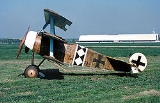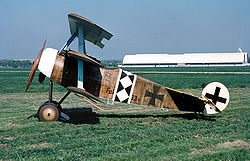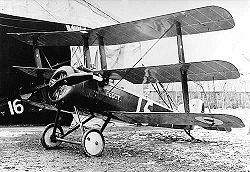
Triplane
Encyclopedia

Fixed-wing aircraft
A fixed-wing aircraft is an aircraft capable of flight using wings that generate lift due to the vehicle's forward airspeed. Fixed-wing aircraft are distinct from rotary-wing aircraft in which wings rotate about a fixed mast and ornithopters in which lift is generated by flapping wings.A powered...
equipped with three vertically-stacked wing planes. Tailplanes and canard
Canard (aeronautics)
In aeronautics, canard is an airframe configuration of fixed-wing aircraft in which the forward surface is smaller than the rearward, the former being known as the "canard", while the latter is the main wing...
foreplanes are not normally included in this count, although they may occasionally be.
Design principles
The triplane arrangement may be compared with the biplaneBiplane
A biplane is a fixed-wing aircraft with two superimposed main wings. The Wright brothers' Wright Flyer used a biplane design, as did most aircraft in the early years of aviation. While a biplane wing structure has a structural advantage, it produces more drag than a similar monoplane wing...
in a number of ways.
A triplane arrangement has a narrower wing chord
Chord (aircraft)
In aeronautics, chord refers to the imaginary straight line joining the trailing edge and the center of curvature of the leading edge of the cross-section of an airfoil...
than a biplane of similar span and area. This gives each wing plane a slender appearance with higher aspect ratio
Aspect ratio
The aspect ratio of a shape is the ratio of its longer dimension to its shorter dimension. It may be applied to two characteristic dimensions of a three-dimensional shape, such as the ratio of the longest and shortest axis, or for symmetrical objects that are described by just two measurements,...
, making it more efficient and giving increased lift. This potentially offers a faster rate of climb and tighter turning radius, both of which are important in a fighter. The Sopwith Triplane
Sopwith Triplane
The Sopwith Triplane was a British single seat fighter aircraft designed and manufactured by the Sopwith Aviation Company during the First World War. Pilots nicknamed it the Tripehound or simply the Tripe. The Triplane became operational with the Royal Naval Air Service in early 1917 and was...
was a successful example, having the same wing span as the equivalent biplane, the Sopwith Pup
Sopwith Pup
The Sopwith Pup was a British single seater biplane fighter aircraft built by the Sopwith Aviation Company. It entered service with the Royal Flying Corps and the Royal Naval Air Service in the autumn of 1916. With pleasant flying characteristics and good maneuverability, the aircraft proved very...
.
Alternatively, a triplane has reduced span compared to a biplane of given wing area and aspect ratio, leading to a more compact and lightweight structure. This potentially offers better maneuvrability for a fighter, and higher load capacity with more practical ground handling for a large aircraft type.
The famous Fokker Dr.I
Fokker Dr.I
The Fokker Dr.I Dreidecker was a World War I fighter aircraft built by Fokker-Flugzeugwerke. The Dr.I saw widespread service in the spring of 1918...
triplane was a balance between the two approaches, having moderately shorter span and moderately higher aspect ratio than the equivalent biplane, the Fokker D.VI
Fokker D.VI
-Bibliography:* Gray, Peter and Owen Thetford. German Aircraft of the First World War. London: Putnam, 1962. ISBN 0-93385-271-1* Taylor, Michael J. H. Jane's Encyclopedia of Aviation. London: Crescent Books, 1993. ISBN 0-51710-316-8....
.
Yet a third comparison may be made between a biplane and triplane having the same wing plan - the triplane's third wing provides increased wing area, giving much increased lift. The extra weight is partially offset by the increased depth of the overall structure, allowing a more efficient construction. The Caproni Ca.4
Caproni Ca.4
-Ca.48:-See also:-References:** **-External links: Contemporary technical description of the Ca.41 and Ca.42 with photographs and drawings.- Video :*...
series had some success with this approach.
These advantages are offset, to a greater or lesser extent in any given design, by the extra weight and drag of the structural bracing, and the aerodynamic inefficiency inherent in the stacked wing layout. As biplane design advanced, it became clear that the disadvantages of the triplane outweighed the advantages.
Typically the lower set of wings are approximately level with the underside of the aircraft's fuselage
Fuselage
The fuselage is an aircraft's main body section that holds crew and passengers or cargo. In single-engine aircraft it will usually contain an engine, although in some amphibious aircraft the single engine is mounted on a pylon attached to the fuselage which in turn is used as a floating hull...
, the middle set level with the top of the fuselage, and the top set supported above the fuselage on cabane struts.
Pioneer years
The Bousson-Borgnis canardCanard (aeronautics)
In aeronautics, canard is an airframe configuration of fixed-wing aircraft in which the forward surface is smaller than the rearward, the former being known as the "canard", while the latter is the main wing...
triplane was built ca. 1908. The first triplane known to have flown was the Goupy No.1, designed in 1908 by Ambroise Goupy, built by Voisin, and flown with a 37 kW (50 hp) Renault
Renault
Renault S.A. is a French automaker producing cars, vans, and in the past, autorail vehicles, trucks, tractors, vans and also buses/coaches. Its alliance with Nissan makes it the world's third largest automaker...
engine. A few weeks later Hans Grade's triplane became the first German-built aeroplane to fly. In the same year Farman modified his original Voisin machine to triplane configuration, and Dorand constructed his military triplane.
In 1909 Bokor constructed his own canard triplane. Through 1909 and 1910 the British aviation pioneer A.V. Roe built a series of four experimental triplanes—types I, II
Roe II Triplane
|-See also:-References:*...
, III
Roe III Triplane
|-See also:-References:*...
and IV
Roe IV Triplane
-Bibliography:* Jackson, A.J. Avro Aircraft Since 1908 London: Putnam, 1965.* Taylor, M.J.H. Jane's Encyclopedia of Aviation London: Studio Editions, 1989, p.91* World Aircraft Information Files London: Bright Star. File 889, Sheet 92...
—before abandoning the design. And in 1911 the Russian Rodjestveisky also constructed a triplane.
The fighting triplanes

World War I
World War I , which was predominantly called the World War or the Great War from its occurrence until 1939, and the First World War or World War I thereafter, was a major war centred in Europe that began on 28 July 1914 and lasted until 11 November 1918...
, some aircraft manufacturers turned to the triplane configuration for fighter aircraft
Fighter aircraft
A fighter aircraft is a military aircraft designed primarily for air-to-air combat with other aircraft, as opposed to a bomber, which is designed primarily to attack ground targets...
. In practice these triplanes generally offered inferior performance to biplanes and only two types were successful enough to be produced, although in relatively small numbers.
Nieuport
Nieuport
Nieuport, later Nieuport-Delage, was a French aeroplane company that primarily built racing aircraft before World War I and fighter aircraft during World War I and between the wars.-Beginnings:...
built a series of triplane prototypes between 1915 and 1917, featuring a top wing heavily staggered backwards to improve the pilot's view and a characteristic triangular strut arrangement bracing the three wings. The design resulted in poor handling and was dropped.
Sopwith developed three different designs in 1916. One, known simply as the Sopwith Triplane
Sopwith Triplane
The Sopwith Triplane was a British single seat fighter aircraft designed and manufactured by the Sopwith Aviation Company during the First World War. Pilots nicknamed it the Tripehound or simply the Tripe. The Triplane became operational with the Royal Naval Air Service in early 1917 and was...
, went into production and became the first military triplane to see operational service. It had equal-span wings of high aspect ratio, mounted on a fuselage very similar to that of the preceding Pup biplane, and braced by one sturdy strut on each side with minimal wire bracing. The type was ordered by both the RFC
Royal Flying Corps
The Royal Flying Corps was the over-land air arm of the British military during most of the First World War. During the early part of the war, the RFC's responsibilities were centred on support of the British Army, via artillery co-operation and photographic reconnaissance...
and RNAS, but in the event the RFC traded theirs for another type and the Sopwith saw service only with the RNAS, where it served with success.
The Sopwith type's performance advantage and early successes over the Albatros D.III
Albatros D.III
The Albatros D.III was a biplane fighter aircraft used by the Imperial German Army Air Service and the Austro-Hungarian Air Service during World War I. The D.III was flown by many top German aces, including Manfred von Richthofen, Ernst Udet, Erich Löwenhardt, Kurt Wolff, and Karl Emil Schäfer...
spurred military interest in the design, especially in Germany and Austro-Hungary. A flurry of prototypes were produced through 1917 and 1918, sometimes reluctantly under pressure from the military. Examples were produced by Albatros, Aviatik, Brandenburg, DFW, Euler, Friedrichshafen, LFG Roland, Lohner, Naglo, Offag, Pfalz, Sablating, Schütte-Lanz, Siemens-Schuckert, W.K.F and in ther USA by Curtiss. None of these went into production. Fokker's V.4 prototype of 1917 (identified by some as the V.3) had unusual cantilevered wings without bracing, the uppermost wing being attached only by cabane struts to the fuselage. The wings vibrated excessively in flight, and the next prototype, the V.5 featured a single interplane strut on each side similar to the Sopwith, but with no wires. This became the prototype of the famous Fokker Dr.I
Fokker Dr.I
The Fokker Dr.I Dreidecker was a World War I fighter aircraft built by Fokker-Flugzeugwerke. The Dr.I saw widespread service in the spring of 1918...
triplane of 1917 which became immortalised as the aircraft most closely identified with Manfred von Richthofen
Manfred von Richthofen
Manfred Albrecht Freiherr von Richthofen , also widely known as the Red Baron, was a German fighter pilot with the Imperial German Army Air Service during World War I...
, the "Red Baron". Although it had a good rate of climb and was highly manoeuvrable it was not particularly fast. Following the break-up of two examples in the air the type was withdrawn from service for strengthening, and by the time it was re-introduced it was no longer at the forefront of performance.
The performance of the fighting triplanes was soon overtaken by improved biplane
Biplane
A biplane is a fixed-wing aircraft with two superimposed main wings. The Wright brothers' Wright Flyer used a biplane design, as did most aircraft in the early years of aviation. While a biplane wing structure has a structural advantage, it produces more drag than a similar monoplane wing...
fighters. However, as late as 1919 three prototype Sopwith Snark
Sopwith Snark
|-See also:-Notes: A similar installation of two Lewis guns on the lower wings of Sopwith Dolphin fighters was tested by No. 87 Squadron RAF.-Bibliography:*Bruce, J.M. British Aeroplanes 1914-18. London:Putnam, 1957....
s were flown.
Zeppelin killers
A few British designers pursued the triplane configuration in the anti-ZeppelinZeppelin
A Zeppelin is a type of rigid airship pioneered by the German Count Ferdinand von Zeppelin in the early 20th century. It was based on designs he had outlined in 1874 and detailed in 1893. His plans were reviewed by committee in 1894 and patented in the United States on 14 March 1899...
role. From 1915, Armstrong Whitworth
Armstrong Whitworth
Sir W G Armstrong Whitworth & Co Ltd was a major British manufacturing company of the early years of the 20th century. Headquartered in Elswick, Newcastle upon Tyne, Armstrong Whitworth engaged in the construction of armaments, ships, locomotives, automobiles, and aircraft.-History:In 1847,...
developed the F.K.5 and F.K.6
Armstrong Whitworth F.K.6
|-See also:-References:*Bruce, J.M. British Aeroplanes 1914-18. London:Putnam, 1957.*Bruce, J.M. War Planes of the First World War: Volume One Fighters. London:Macdonald, 1965....
prototypes. These were large three-seat types with twin engines and the middle wing of noticeably longer span than the others. Then in 1917 Blackburn produced their single-seat triplane
Blackburn Triplane
-External links:*http://www.flightglobal.com/pdfarchive/view/1919/1919%20-%201580.html*http://www.flightglobal.com/pdfarchive/view/1939/1939%20-%201632.html*http://www.flightglobal.com/pdfarchive/view/1959/1959%20-%201251.html...
. It was something of a throwback, featuring a pusher propeller and boom-mounted empennage in the manner of an earlier era. The arrangement was intended to allow fitting of an upwards-firing 2-pounder recoilless gun in the forward fuselage. Neither type progressed beyond the prototype stage.
Bombers and transports
The Caproni Ca.4Caproni Ca.4
-Ca.48:-See also:-References:** **-External links: Contemporary technical description of the Ca.41 and Ca.42 with photographs and drawings.- Video :*...
of 1917 entered service with the Italian air force as a heavy bomber
Bomber
A bomber is a military aircraft designed to attack ground and sea targets, by dropping bombs on them, or – in recent years – by launching cruise missiles at them.-Classifications of bombers:...
in 1918. It was a successful design for its day and many variants were produced. Later on, after the war, Caproni re-numbered many of these variants as new types. The unsuccessful Caproni Ca.60
Caproni Ca.60
|-Video:A Mammoth of the Air, a 1921 silent film of the Ca.60, can be seen at -External links:*...
prototype transatlantic seaplane had three sets of triplane wings taken from the Ca.4, making nine wings in all, and is generally classified as a multiplane
Multiplane (aeronautics)
In aviation, a multiplane is a fixed-wing aircraft configuration featuring multiple wing planes. The wing planes may be stacked one above another, or one behind another, or both in combination....
.
From 1918, Bristol developed a series of heavy triplanes which, like the Caproni design, appeared in different variants aimed at different roles. The first was the Bristol Braemar
Bristol Braemar
|-See also:...
bomber, flying in 1918 with the Mk II version in 1919. The Bristol Pullman
Bristol Pullman
|-See also:...
14-seat transport variant flew in 1920. This was followed by two examples of a new, larger design for a military freighter - the Bristol Tramp
Bristol Tramp
|-See also:-External links:*...
.
The Tarrant Tabor
Tarrant Tabor
- See also :* Witteman-Lewis XNBL-1 - a design by Barling for a similar aircraft for the US Army- External links :* http://avia.russian.ee/air/england/tarrant_tabor.php* http://members.aol.com/wwatrans/unique.htm...
, another and much larger British bomber, was built with three wings to carry the 6 engines required. It crashed on its maiden flight in 1919. Its designer Walter Barling went on to create the similar-sized American Witteman-Lewis XNBL-1
Witteman-Lewis XNBL-1
The Wittemann-Lewis NBL-1 "Barling Bomber" was an experimental long-range, heavy bomber built for the United States Army Air Service in the early 1920s...
, known as the "Barling Bomber", which first flew in 1923.
Racing triplane
In 1921 the "Cactus Kitten" racing triplane, formerly the monoplane "Texas Wildcat 1 (there was a biplane Texas Wildcat 2"), wascreated. It is the only design in history having gone from a monoplane to biplane to triplane configuration. Referred to as the Curtiss-Cox racer, designed by Cox, a Texan who sponsored it, the Cactus Kitten placed 2nd in the 1922 Pulitzer race behind a Curtiss biplane. It was powered by a 435 hp Curtiss C-12 engine with a 20' wingspan. In its triplane configuration it surpassed it's monoplane and biplane antecedents in handling and speed, and for a brief moment, the triplane was once again being noticed, the Kitten being touted as being the world's fastest plane in 1922, being capable of surpassing 200 miles per hour. The same year it was donated to the Navy and used as a trainer for the 1922 Pulitzer race, fame having proven very fleeting.
Tandem triplanes
A tandem triplane has two sets of triplane wings, fore and aft. Few have been made.Dufaux produced Switzerland's first native aircraft design in 1908, as a tandem triplane with a smaller biplane horizontal stabiliser.
The 1909 Roe I Triplane has also been described as a tandem triplane due to its relatively large triplane aft plane.
The Fokker V.8
Fokker V.8
After the initial success of the Fokker Dr.I triplane, Anthony Fokker proposed a quintuplane, reasoning that if three wings were good, five would be even better. Reinhold Platz, chief engineer for Fokker, was at first shocked by the idea: further thought only strengthened this reaction. ...
of 1917 was another tandem design although not a true tandem triplane, having a triplane fore wing, biplane rear wing and monoplane tail stabiliser.
In 1921, the Italian Gianni Caproni mated three stacks of triplane wings from his Ca.4
Caproni Ca.4
-Ca.48:-See also:-References:** **-External links: Contemporary technical description of the Ca.41 and Ca.42 with photographs and drawings.- Video :*...
series to a single fuselage in a tandem triple triplane arrangement, to create the Caproni Ca.60
Caproni Ca.60
|-Video:A Mammoth of the Air, a 1921 silent film of the Ca.60, can be seen at -External links:*...
Noviplano prototype long-range airliner. It proved unstable and crashed on its first flight.
A further example was under construction in Kansas City, USA as late as 1922.
Recently, the term "tandem triplane" has been used for some new monoplane types that have active canard
Canard (aeronautics)
In aeronautics, canard is an airframe configuration of fixed-wing aircraft in which the forward surface is smaller than the rearward, the former being known as the "canard", while the latter is the main wing...
surfaces in addition to conventional wings and horizontal tailplane. A configuration having three comparable lifting surfaces in tandem is more correctly referred to as tandem triple or tandem triplet, and is not a triplane as such. These modern types may also be compared to the pioneer Voisin-Farman I
Voisin-Farman I
The 1907 Voisin biplane was the first successful powered aircraft designed by aeronautical engineer and manufacturer Gabriel Voisin. It was used by the French aviator Henri FarmanBorn in France to British parents, Henry Farman took French nationality in 1937 to make the first heavier-than-air...
and Curtiss No. 1
Curtiss No. 1
-References:* * * The Illustrated Encyclopedia of Aircraft , 1985Orbis Publishing...
which also had a large main wing with smaller fore and aft planes; the smaller planes were not regarded as part of the main wing arrangement, and they were not described as tandem types.

